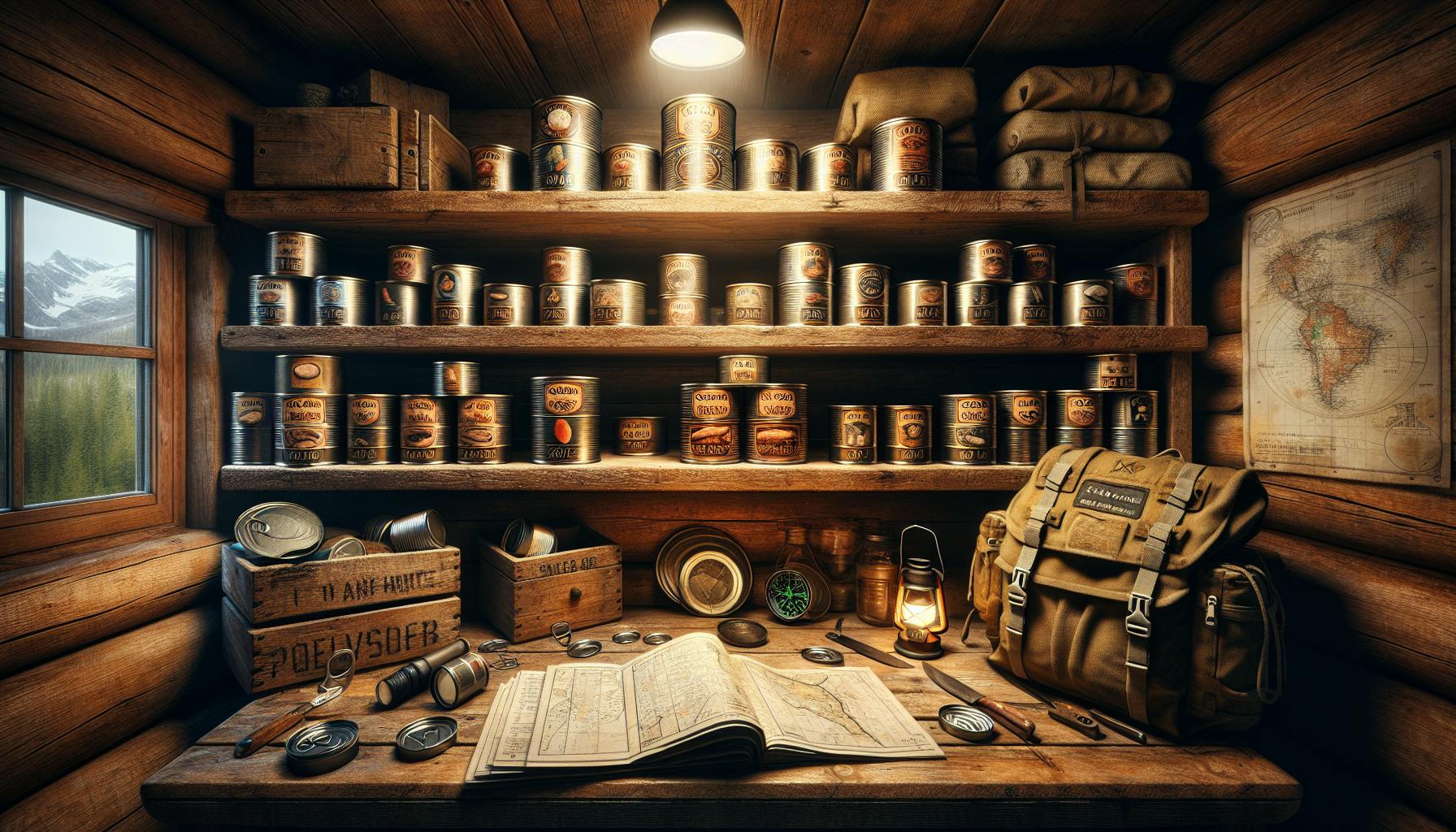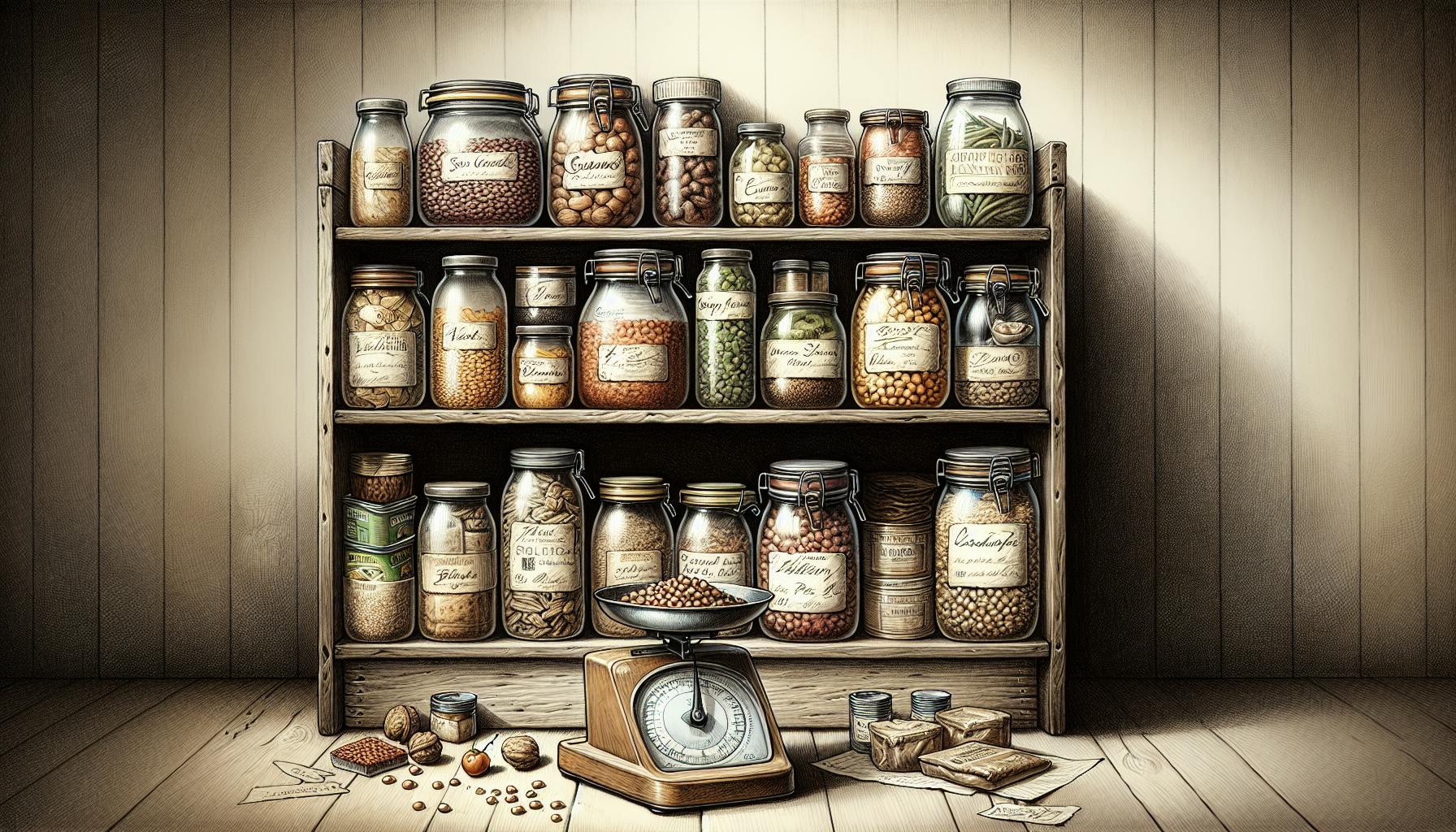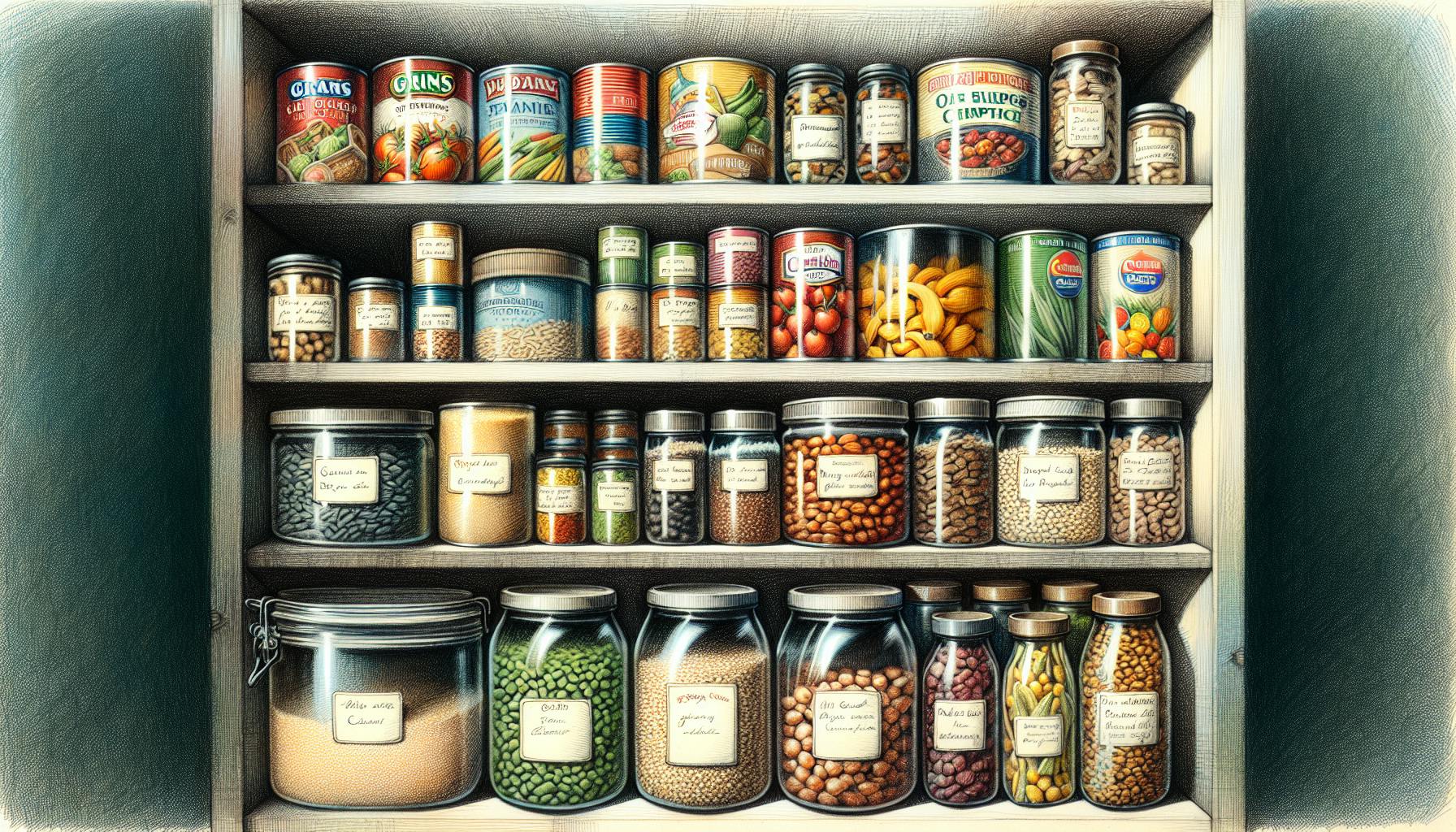Selecting the right beginner prepper food kit can be overwhelming for those new to emergency preparedness.
By focusing on foundational needs like nutrition, taste, and cost-effectiveness, it's possible to find great starter kits to build confidence without too much complexity.
In this roundup, we'll review 5 of the best entry-level prepper food kits that cater to basics like shelf life, serving size, food quality, and budget.
Introduction to Prepper Food Kits
Prepper food kits are pre-packaged sets of non-perishable food and water designed to sustain an individual or family during an emergency situation or disaster when access to normal food supplies is disrupted. These kits cater to beginners who are just getting started with emergency preparedness and want an easy way to build up a basic food reserve.
Defining Prepper Food Kits
Prepper food kits contain freeze-dried or dehydrated meals, snacks, and drinks that have long shelf lives of 5-25 years. They are packaged in buckets or pouches for convenient storage. Many kits are designed to sustain one person for a certain duration, typically ranging from 72 hours to 1 month. They aim to provide balanced nutrition in an easy grab-and-go format.
Who Beginner Prepper Food Kits Are For
Beginner prepper food kits are designed for those who are new to emergency preparedness and looking for an approachable way to get started. The pre-packed kits take the guesswork out of building a basic food supply and help beginners overcome the initial learning curve. They appeal to those seeking basic disaster insurance without too much complexity.
Benefits of Prepper Food Kits
The main benefits of beginner prepper food kits include:
-
Convenience: The meals come pre-packaged so beginners don't have to research, shop for, and assemble all the components themselves. This saves significant time and effort.
-
Nutritional balance: The kits include a variety of entrées, sides, snacks, and drinks designed to provide balanced nutrition for short-term emergencies. This removes the stress of ensuring nutritional needs are met.
-
Affordability: Buying a full kit is typically cheaper than assembling all the components individually as a beginner. The bulk pricing helps keep costs down.
-
Peace of mind: Having an emergency food supply boosts confidence in being able to handle disasters. It's an empowering first step towards self-reliance.
-
Easy storage: Most kits are designed for convenient space-saving storage with a long shelf life, making it simple for beginners to incorporate them into their homes.
By providing an easy, affordable way to put together a basic food reserve, prepper kits help beginner preppers confidently take the first step towards increased preparedness for emergencies.
What is the best food for long term preppers?
When it comes to prepping long term food storage, there are a few key things to consider:
Grain Types
- Soft grains like oats, rye, and quinoa are stable for about 8 years on average. With ideal storage conditions, their shelf life can be extended to 20 years.
- Hard grains like buckwheat, corn, wheat, and flax can last 12-30+ years with proper storage. These make great additions for long term food prepping.
Storage Conditions
- Store grains in airtight containers in cool, dark places to maximize shelf life. Consider adding oxygen absorbers as well.
- Rotate stock using the "first in, first out" system to use items before they expire.
- Hard grains have naturally longer shelf lives, but both soft and hard grains can last decades with ideal storage.
Recommended Long Term Storage Foods
Some of the best foods for hardcore preppers include:
- Hard grains like wheat, rice, corn, buckwheat, amaranth
- Dried beans and lentils
- Canned goods
- Honey, salt, sugar
- Freeze-dried produce
Focus on nutrient-dense non-perishables perfect for stockpiling. Keep conditions cool, dark, and airtight for best results. And be sure to integrate the best prepper food kits that have optimal mixes of these hardy ingredients.
What is the best brand of emergency food supply?
When it comes to selecting an emergency food supply, there are a few top brands that stand out for quality, variety, and affordability.
Famine Fighter
Famine Fighter offers a nutritionally balanced selection of freeze-dried and dehydrated foods with a 25 year shelf life. Their food kits provide complete, balanced meals tailored for emergency preparedness. With gluten-free and vegetarian options, Famine Fighter aims to be inclusive.
Roundhouse Provisions
Roundhouse Provisions provides tasty, easy-to-prepare meals using high quality ingredients. Their food kits include breakfasts, entrees, fruits, vegetables, and snacks. With convenient cooking pouches, their meals can be prepared with just the addition of hot water.
4Patriots
The 4-Week Survival Food Kit from 4Patriots contains over 100 servings of nutritious food with a shelf life of up to 25 years. The kits come packaged in durable buckets for easy storage. 4Patriots also offers sample packs to try their products.
My Patriot Supply
My Patriot Supply allows customers to build personalized emergency food kits to meet their household’s unique needs. Their food comes in vacuum-sealed pouches and has a shelf life of up to 25 years. My Patriot Supply is transparent about their sourcing and manufacturing as well.
When selecting an emergency food supply, be sure to consider nutritional balance, ease of preparation, shelf life, quality of ingredients, and any dietary needs. Testing samples can also help determine which tastes best for your family.
What is the absolute best survival food?
When building an emergency food supply, it's important to have nutrient-dense foods with a long shelf life. Some top options to keep in your pantry include:
Peanut Butter
An excellent source of protein, fats, and calories. Choose natural peanut butter rather than hydrogenated oils. Stays fresh for 3-4 months once opened when properly stored.
Whole-Wheat Crackers
Provides carbohydrates and fiber. Look for low/no sugar options. Stays fresh 3-6 months in airtight container. Pair with peanut butter for protein.
Nuts and Trail Mixes
Great source of protein, healthy fats, and antioxidants. Go for unsalted when possible. Lasts up to a year when unopened.
Cereal
Choose whole grain cereals and granolas high in fiber. Pair with shelf-stable milk or powdered milk. Sealed boxes last 6-12 months.
Granola Bars
Another good carbohydrate source. Seek options with protein and fiber, and minimal added sugars. Keeps 6-9 months sealed.
Dried Fruits
Raisins, apricots, cranberries. Excellent for vitamins and minerals. Can last up to a year when stored properly. Choose unsweetened if possible.
When building your emergency food supply, focus on nutrient-dense, non-perishable foods like those outlined above. Having a diverse mix of proteins, grains, fruits and veggies is key for health. Track expiration dates, store in cool, dark spaces and utilize first-in-first-out.
sbb-itb-b932644
What are the best food to stockpile?
When building your emergency food supply, focus on nutrient-dense non-perishable foods with a long shelf life. Here are some of the best options to stockpile:
Canned and Dried Goods
- Canned meats like tuna, chicken, and salmon are packed with protein. Choose options packed in water rather than oil.
- Canned beans, vegetables, and fruits are convenient, budget-friendly choices. Opt for low-sodium versions when possible.
- Dried beans and lentils are inexpensive sources of fiber and protein. Stock up on a variety so you can make different dishes.
- Whole grains like brown rice, quinoa, and oats have good nutritional value and last for years when stored properly.
Shelf-Stable Dairy and Protein
- Powdered milk and shelf-stable UHT milk can be reconstituted when fresh milk is not available.
- Nut butters like peanut and almond butter are calorie-dense and full of protein and healthy fats.
- Jerky, pemmican, and freeze-dried meats offer lightweight protein options.
When building your stockpile, focus on versatility, nutrition, and your family's needs and tastes. Avoid overly processed items and sugary snacks which lack nutrients. Rotate and replace items as they near expiration dates.
Key Considerations When Selecting a Beginner Prepper Food Kit
This section outlines the most important factors for newcomers to consider when picking out a survival food kit to meet their basic needs.
Shelf Life and Storage
Focus on kits with ingredients that last 10-30 years to reduce the workload of rotating supplies. The best prepper food kits will have a long shelf life, allowing you to store them for emergencies without having to frequently replace items. Seek out freeze-dried and dehydrated ingredients, as these can last decades when properly stored.
Nutritional Content and Best Tasting Options
Seek kits with a nutritionally balanced macronutrient profile and sufficient micronutrients from fruits, vegetables and lean protein, while also considering the best tasting survival food kits. Look at the nutritional labels to ensure the kits contain balanced ratios of carbohydrates, protein, and fat. Having fruits, vegetables and lean protein sources helps provide essential vitamins and minerals. At the same time, consider tastiness, as you want something palatable if relying on these rations.
Serving Size and Duration
Prioritize kits sized for your household's unique needs, typically ranging from a 60-serving option to a 2-week supply. Calculate the number of people in your household and the intended duration to determine the ideal kit size. For a single person, a 60-serving or 2 week supply is likely sufficient. Larger households may need a month supply or more. Consider scaling up gradually instead of buying a large kit upfront.
Food Security and Taste Testing
To prevent waste, test samples of a kit before fully stocking up to ensure it aligns with your tastes. Order sample packs from a few top rated brands to compare the taste and texture. This allows you to find something appetizing without getting stuck with a large kit you won't eat.
Budget and Cost-Effectiveness
Prepare for the upfront investment emergency food requires, but high-end kits aren't essential for beginners. Expect to spend $100-500 for a basic starter kit, depending on household size and duration. More premium options with bonus items can run $1500+. As a newcomer, start with an affordable but reliable kit before upgrading.
Reviews of Our Top Beginner Prepper Food Kit Picks
This section explores highly rated, quality basic prepper food kits tailored for newcomers.
Wise Company 60-Serving Prepper Pack
This affordable 2-day kit covers basics like entrees, breakfasts, drinks, and snacks. The Wise Company 60-Serving Prepper Pack features convenient boil-in-bag meals and just-add-water drinks and cereals. With tasty options like creamy pasta alfredo, savory stroganoff, apple cinnamon cereal, and more, it provides balanced nutrition to get you through a short-term emergency. Though not a long-term solution, its compact size and budget price make it a great starter kit for those new to prepping.
Augason Farms 30-Day Food Storage Emergency Pail
Great value on a vegetarian-friendly month-long supply with convenient carrying handle. The Augason Farms 30-day pail utilizes #10 cans to provide hearty servings of quick-cooking rice, pasta, and potato options, plus breakfast shakes and snacks. As a bonus, the kit is 100% vegetarian friendly and includes an easy-carry handle for portability. With expert emergency food packing for maximum shelf life, it brings exceptional value at this quantity. If seeking more than 3 days of meals, it's one of the best prepper food kits.
Mountain House Classic Bucket
Tasty, easy-to-prepare rice, pasta and breakfast options for a 3-day emergency supply. Trusted brand Mountain House loads this bucket with simple, delicious staples like chicken fried rice, spaghetti with meat sauce, eggs with bacon, and granola with milk and blueberries. Just add hot water, wait 10 minutes, and you have a hot, tasty meal ready to eat. With easy portability and a 3-day supply for one adult, it provides good insurance against short-term crises at a reasonable price point for a survival food kit.
ReadyWise Emergency Food Supply with Water Pouches
Top-rated 7-day kit with bonus emergency survival water pouches and emergency ration bars. This ReadyWise kit covers breakfast, lunch, dinner and snacks for a full week for one person. The included ration bars and water pouches help round out the key basics. With a total of 104 servings packing 2,400 calories per day, users praise both the quality and quantity provided at this kit's affordable price tag, making it a great bang-for-your-buck emergency food supply.
Survive2Thrive Organic Preparedness Pail
Premium non-GMO fruits, veggies, proteins and whole grains last up to 25 years. For those wanting top-notch organic ingredients, Survive2Thrive offers a pail packed with hearty servings of hearty beans, quinoa, steel-cut oats, chia, flax and more. With care taken to source premium ingredients, the company says its non-GMO, gluten-free food supply can last up to 25 years when unopened. If wanting to stock up for the long haul with quality nutrition, it deserves a look as a basic prepper food kit option.
Building Upon Your Beginner Prepper Food Kit
Once newcomers have established a basic emergency food supply, this section explores next steps to take preparedness to the next level.
Expand Supply Duration
Gradually building towards a robust multi-month or 1-year food supply can significantly boost your preparedness as budget allows. Consider setting supply duration goals, like 3 months, 6 months, or 12 months, and slowly accumulate additional food kits and ingredients over time to reach your target. Storage space may be a limiting factor, so get creative with space-saving storage solutions.
Diversify Food Sources with Single Ingredients
Supplement your food kits with a deep pantry stocked with nutrient-dense single ingredient staples like rice, beans, pasta, oats, nut butters, dried fruit, nuts, seeds, and more. This diversifies your food sources and allows you to assemble customized meals. Consider vegetarian-friendly proteins like textured vegetable protein (TVP) and dried lentils.
Water Storage Solutions
Store at least 1 gallon of water per person or pet per day via bottled water or water storage containers. Have portable water filtration devices like Lifestraws or Sawyer filters as a backup. Rotate and refresh water supplies every 6 months.
First Aid Preparedness and Best Car Emergency Kits
Assemble comprehensive first aid kids designed for likely disaster medical issues like trauma, infections, respiratory issues, etc. Well-stocked car emergency kits are vital for on-the-go preparedness. Choose kits with jumper cables, tools, tire inflator, flashlight, blankets, food/water, and more.
Emergency Tools and Survival Tabs
Round out your prepper supplies with batteries, flashlights, matches, multi-tools, duct tape, tarps, emergency blankets and tents, hand crank radio, and survival tabs for quick supplemental nutrition.
Key Takeaways for Beginner Preppers
As a newcomer looking to invest in your first emergency food prepper kit, here are some key points to consider:
Start Small, But Start
The idea of building a 6-month supply can seem daunting. Beginner kits allow you to start small but take the first, critical step in preparedness.
Focus your initial kit on establishing the basics - core food and water needs plus first aid. Once you have the essentials covered, you can build up gradually over time.
Focus on Foundations First
When just getting started out, focus more on the foundations rather than fancy gadgets. Ensure you have secured:
- A basic food supply
- An emergency water supply
- A first aid kit
Get these core preps solidly in place before moving onto more advanced or niche items.
Consider Comfort Foods
While you want nutritionally balanced food, don't underestimate the value of some comfort foods as well. Stressful situations warrant some favorite tasty treats beyond just macro balances.
Consider working a few comfort snacks into your food supply - it's for your mental health too!
Pair with General Emergency Plan
Combine your beginning food kit with general preparedness steps like:
- Creating an evacuation plan
- Making an emergency contacts list
- Picking meet-up spots
- Etc.
This ensures you have a well-rounded action plan in place to respond in an emergency, not just supplies.


